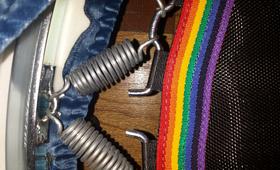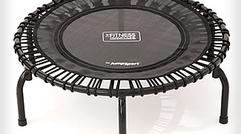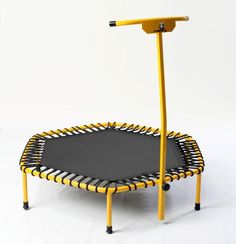If using considering a rebounder and you are very light weight or have arthritis, the wrong rebounder can cause arthritis to flair up or if very light weight the minimum tensile strength is too low to do the proper lymphatic Health bounce, it can add pressure to the knees. Some rebounders relieve 70% of the ballistic impact and others up to 90+, such as low tension bungee rebounder. A rebounder that relieves 80 to 90 percent of the ballistic based on your weight should be the best rebounder to do the Health Bounce, (see buying for your weight page.
No Jarring at the bottom of the bounce:
A mat that is too stiff will create a ballistic impact at the bottom of the bounce. The way bowling ball hits that mat can be seen. Pay attention to how long the ball is in contact with the mat.
Too Stiff for one may not mean too stiff for another.
Please let us know your weight. If you are 120 lbs you will find a rebounder to be more stiff than another person weighing 180. At 2 to 3 g forces, that extra 60 lbs triples as you jump. Having separate tiers that adjusts to the weight prevents this problem. On a these, a person that is 300 lbs or 120 lbs gets the same bounce, and same g force.
Bounce # VS. G-Force
Which do you want to sacrifice?
"You can get a rebounder that bounces more with more G-force but you want to avoid the ballistic impact rating.
If you are aiming at VERY little ballistic impact, you get a soft, mushy bounce with less G force.
The bounce that most people desire is a bounce that a rebounder can adapt to their weight. If you bounce on the major brand rebounders, you will naturally gravitate towards the most energetic bounce that you can put out more energy per minute due to more contact with the mat with more bounces per minute. The rebounders that gives you the most bounces per minute that gives even sink and rise without using too much expending unnecessary energy to get lift are the ones you will notice instantly if you are picking out a rebounder based on your weight. I do have a quiz to help you decide for any reason you aren't able to jump on all of them before deciding.
Rebounders are not like trampolines in that you want to get as much lift as you can with the least amount of ballistic impact. Rebounders work the opposite.
Firm vs soft bounce
A firm mat will give more a g force. does a firm mat give too much bounce? A firm bounce can give more G force but do you sacrifice the amount of bounces per minute? Tiered rebounders have solved the problem of fewer bounces per minute. The last tier gives the 3 g force the other 2 tiers give the softness. This is how the 2 tiers take out the jarring and the last tiers help give the lymph drainage.
A triple tiered rebounder is made to take out 7/8ths of the ballistic impact in every tier. The tiered rebounder is the one that I have chosen to be optimal for moving lymph. For exercise only, you can get by with a cheaper one as long as the ballistic impact rating is low.
An exaggerated example of a bounce of an aged untuned rebounder is when we put brand new springs on one half of the rebounder and kept the original springs that were used on a rebounder for 2 years. With one half having new springs and the other half having used, older springs, we noticed the difference how the more the springs were stretched the more milliseconds it gave in the belly of the bounce. As the springs become softer with age, most of the tension is spread in the belly of the spring that gives a longer bounce. What is happening is it is absorbing too much of the ballistic impact so that at the bottom of the bounce you get less g force, lowering the expectation of 3 g force.
When the bounce becomes too soft, IT IS TIME TO CHANGE SPRINGS, even if the springs didn't break. You don't just have to change springs when you see a spring hook break. Only a few brands of springs that had high tensile strength showed no difference when we put the old springs on one half and new on the other. These were the springs that manufacturers claimed you don't EVER HAVE TO change springs during the lifetime of their rebounder. On triple tiered springs, it appears that the belly of the spring never stretched out to the point of over stretching because of the two additional tensile strengths. I am still trying to figure out exactly what type of steel alloys they put in the triple tiered springs. The way it is designed gives just the right number of milliseconds of softness before the 3 g force squeeze. People that are heavier engage the 2nd tier as part of this landing phase before the 3rd tier delivers that bottom g force. Lighter people experience the 2nd tier as the bottom of the landing phase. If a child jumps on it, he may only engage the first tier and never the 2nd or 3rd.
If you want a softer bounce or a harder bounce, 2 G forces or 3 G forces when doing the Health Bounce, study the types of springs, short or long bellies, narrow or very wide bellies in proportionate to the length of the bellies, and if the spring quality has a high or low tensile strength to begin with, and knowing what type of bouncing you will be doing, lymphatic or mostly for exercise, or both, will determine what type of rebounder to get that will give you the most bounces per minute with the least exertion (or more exertion if you want). The reason some people don't get much benefit from rebounders is that they just pick out one thinking they all feel the same and deliver the same flush just because they are exercising on it.
Why do some rebounders take less time to get results?
It's not just about how many bounces you get a minute which means how many flushes you get in the one way valves in the lymphatic vessels, it IS ABOUT THE G FORCE ALONG WITH THE BOUNCE. With a heavier spring, like a triple tiered spring rebounder, for example, I don't have to jump so high out of the air to get the 3 G force unlike a rebounder that you have to spring high into the air to get G force. The Lympholine, has very light springs but has spring loaded feet which was the closest to the a tripled tiered spring in that it keeps you very close to the mat when trying to do the Health Bounce. The cheap rebounders many people buy actually can give more than 3 G forces which kills the knees and ankles but the lighter springs don't give enough. 3 G forces when barely leaving the mat seems to be the equilibrium point where most people get the most benefits with the least amount of jarring. Remember, if you have to go much higher than just above the mat to get these 3 g forces, even though a rebounder might be soft, that softness is not what hurts the knees and ankles, it's the coning in and inversion of the feet when the mat has to go down more than you would if you just barely came off the mat.
Those who have health issues, please do not rebound more than 2 minute intervals.
For those who have inflammation or any swelling in the body from a sluggish or blocked, oxygen starved lymphatic system, if you do it more than 2 minutes, all the thickened, dirty toxic lymph cannot be processed by the liver fast enough. If too much gets circulated at once, it can further degeneration and formations of even more toxins that are just moved from the lymph to the liver. Most people are in homeostasis when the body is inflamed. The way to drain the lymphatic system is to do it slowly. The clearing process if done really quick will make most people sick to their stomach. But then again, most people are not getting enough bounces per minute with enough g force anyway because they are working out ones that jar the body and lock the valves in one direction. The Health Bounce on the right rebounder gives that milking motion to clear out the system. With 3 g forces without being airborne too long, 2 minute intervals is more than enough for those just staring out.
A final word on bounce:
You don't want to much bounce, you don't want to little bounce. In my opinion, the best bounce is from a rebounder that adjusts to your body weight no matter where you jump on the mat. You want to get the most benefit out of the rebounder without putting an unnecessary strain on the body. You can get 3 G forces by jumping slightly higher on one that is too soft for you or you can jump slightly lower on one that is more responsive and jump more times per minute. Before picking out a rebounder, it is helpful to decide if you want to only exercise, only do the Health Bounce, or one that is designed to do both. There are some rebounders that were designed with the Health Bounce in mind and others designed just to jog on that you can find at many sporting good stores.
Enough G force
Rebounding with springs that do not create enough G force will have a hard time creating the negative pressure on the lymphatic system, the blood sewer system's one way valves that pump the waste to the liver and then to the intestines to be eliminated. Some rebounders are too soft and do not have enough resistance to cause the negative pressure to build resistance to cause normal cellular respiration. Enough G force is needed to send blood flow to the cell membrane and send new proteins and remove used up blood proteins out. Repetition of G forces when fortifying the cell membranes is where the value is in rebounders that let you do the Health bounce without too much amplitude and few more bounces per minute. A rebounder can bounce you higher in the air, and you might get more G force but you sacrifice fewer bounces per minute, stopping and starting the negative pressure. With a rebounder that gives the Health bounce, the negative pressure never stops like it would on a rebounder that gives you excess air time. The better rebounders can get you enough G force to do the Health bounce without having to jump near the edges where there is more firmness. The heavier the carbon of the spring and the more tapered it is the more a spring will adapt to your weight so you can bounce anywhere on the mat and get similar g force. You might jump more times per minute standing near the edge but different tensions in the tapers in the spring adjust for G force. In the middle of the mat, you can get a softer bounce and less bounces per minute but different the tapers engage and compensate to give you the similar G force as jumping near the edge. Most rebounders jar you the further away you space your feet because the springs have just a single tension though out. A tiered spring will give you the G force at the end of each tier. If you are not heavy enough for the next tension to engage, then your bounce is done and you only use the tiers you need.
On a quality rebounders you should be able to jump anywhere on the mat and not get difference G forces on the mat. If a rebounder gives too much amplitude it will cone in more and invert the ankle and if the spring is not tapered it will have too much tension changes in different sections of the mat which can through you off balance. You should get nearly the same G force near the edge as well as the same near the center of the mat. Only the amplitudes should change.
Consumer Notice: Heavy people beware
A word about low carbon steel springs
Low carbon springs have lower maximum tensile strength but higher minimum tensile strength. This is bad because as a heavier person will max out the minimal tension. Many heavier people complain of their rebounder not giving the same resistance as when it was new. If a 200 pound person is going to be applying just say 200 Newtons of force by doing the Health bounce and the rebounder is rated only or 175 Newtons, then the springs will start losing their yield strength and either the hooks on the ends will snap off first or they will just lose their tension and for 20 years while someone has their rebounder they are getting an inferior bounce.
The Needak and Cellerciser spring are almost the same weight, 92 and 106 grams. The tensile strength on the Cellerciser spring is higher but the Needak has more yield. The Cellerciser bottoms out with heavier people. Since the Needak is also rated for 300 pounds like the Cellerciser spring, the Needak utilizes the entire coils of its spring while the same 150 pound person on the Cellerciser uses mostly just the first and 2nd tier. The Cellerciser rebounder is the rebounder I found to be the least jarring for weights up to 300 pounds. Once the spring CANNOT STRETCH anymore, this is when the jarring happens, because the mat cannot go down any further. When the mat yields too much to the floor this is when springs start snapping.
The Rebound Air has the least yield due to its low coil count spring. It is most similar in feel to the Lymphaciser if buying a rebounder to do the Health bounce only. The Cellerciser gives slightly fewer bounces but the G force is spread thoughout the acceleation. The Needak has the most exaggerated decellerations and accelerations.
Overall, the Cellerciser wins for the least jarring rebounder. The Needak come in 2nd.
Note: Because everyone is asking, I will say that the bungee rebounders are the least jarring but I am not including it because I can't do the lymphatic Health bounce. The problem of jarring is not there but inversion and people with knee problems and ankle problems have another problem to deal with, inversion and pronation, the turning inward of the feet that puts just a little pressure on the joints. Over time, if the bungee is too soft, this stress over time can make the joints in my ankles and knees very tender. The best bungee rebounder for preventing inversion is the smallest sized Jumpsport.
If you are interested in trying a Jumpsport or the Cellerciser, see my store page. I have the best deals on both.
If you need help choosing, email me your situation as far as any concerns you may have and I will help you pick. Contact me on my contact page here.
Many people call me with hip problems. A spring rebounder is always going to be easier on the joints than any other type. If the rebounder inverts your ankles too much, it can put pressure on the hip over time. Most people that get the wrong rebounder don't know this because the ballistic impact from a rebounder that inverts the ankle happens over time. By this time the person cannot return the rebounder. (We give 30 days for anyone to try out any rebounder we recommend in case someone wants to try to see if they like it). Many people buy bungee rebounders but if buying a bungee, make sure it is a Jumpsport as they have the smallest mat that you can adjust the tension level so the feet don't invert and the tension is more firm. (the 370 model is the model I recommend if someone wants to move lymph and they feel they want a bungee over a spring). There are advantages and disadvantages of both. For hip problems, the two that I recommend are the Jumpsport 370 and the New Cellerciser.
Compare the top Lymphatic Rebounders
New Zealand Lymphaciser VS CELLERCISER VS JUMPSPORT
FREE BONUS PAGE
The most important page on this site
The WRONG WAY to do the lymphatic Health Bounce
Go to Health Bounce Page
#1 Rule of Rebounding
for lymphatic rebounding
Always land on heels and roll to toe.
This can only be done with a minimal initial tension based on your weight.
Call 1-877-354-3778 for help choosing a rebounder.
...because not all rebounders are designed for detox and lymph drainage
We're Open Now
1-877-354-3778
Ask for Alex
LymphaticRebounding.com
LYMPHACISER
NEEDAK
CELLERCISER
REBOUNDAIR
JUMPSPORT
BELLICON
LYMPHOLINE
HEXAGONAL
BUNGEE
The newest
bungee rebounder.
We're Open Now
1-877-354-3778
Ask for Beth
















